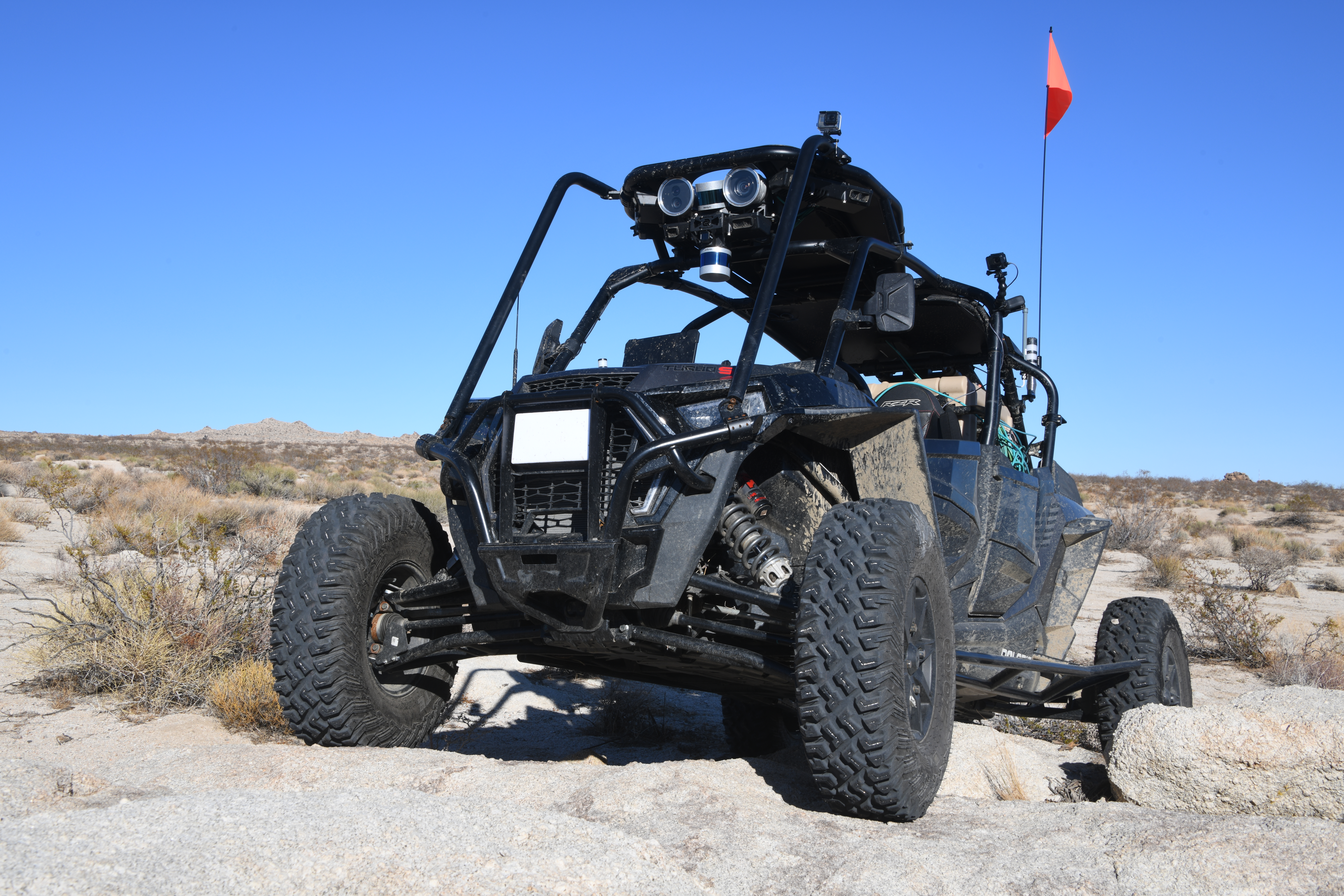The U.S. military had a need. A contest among driverless cars in the desert attempted to fill it.
On October 8, 2005, a blue Volkswagen Touareg modified with sensors for mapping beat 22 other robot vehicles to win the Defense Advanced Research Projects Agency (DARPA) Grand Challenge, a 132-mile driverless car competition across desert terrain near the California-Nevada state line funded by the Department of Defense. The Stanford Racing Team, the winners who built and operated the car, called Stanley, won the $2 million prize with a time of 6 hours, 53 minutes.
“It was truly the birth moment of the modern self-driving car,” says Sebastian Thrun, the former leader of the Stanford Racing Team who is now the head of an artificial intelligence startup company. “It was the moment when business leaders … witnessed what’s possible, when all the key players today were involved in these challenges, and when the key new generation of researchers emerged.”
From now until 2026, Stanley, a name team members derived from Stanford University, will be on view at the Smithsonian’s National Museum of American History in a new display called “Road Warriors” that is focused on the car’s military origins and legacy. In 2005, the United States was involved in several conflicts in the Middle East, and the nation’s military wanted to use the DARPA Grand Challenge to accelerate the development of autonomous vehicle technologies that could be applied to help military personnel.
Part of the goal of driverless vehicles was to protect soldiers from improvised explosive devices (IEDs) on roads, says Carlene Stephens, a curator in the museum's Division of Work and Industry who oversees automatons and robots.
“This blue behemoth was one effort to find a solution and one effort to put an end to tragic injuries and death,” she says.
/https://tf-cmsv2-smithsonianmag-media.s3.amazonaws.com/filer_public/40/1d/401dea03-7dfc-403f-b541-bccfb151f973/jn2024-00966.jpg)
To viewers, Stanley may appear like a race car. It’s big, bright blue and covered in logos. “Stanley is a really charismatic object,” Stephens says. But the DARPA Grand Challenge was more than a race. It demonstrated the feasibility of self-driving vehicles, and Stanley represents what happens when the military puts money and effort into developing new technology.
“It almost instantly finds civilian applications,” Stephens says.
Prior to the 2005 DARPA Grand Challenge, efforts to build self-driving cars had led nowhere, says Thrun, a scholar of computer science at Stanford University. In 2004, the year of the first challenge, none of the 15 finalists completed the 142-mile route from Barstow, California, to Primm, Nevada, to claim the $1 million prize. The farthest car made it just over seven miles.
To win the 2005 challenge, which had five finishers, the Stanford team recognized it was a software race, not a hardware race, and figured out from the start that the problem wasn’t to build a better vehicle, it was to build a smarter robot, says Sven Strohband, a lead engineer on the Stanford Racing Team at the time.
Stanley is equipped with five roof-mounted light detection and ranging (lidar) units—the objects that look like coffee cans that sit on top of the vehicle—to build a map of the environment and help the vehicle navigate. Stanley also used wheel odometry, a highly accurate GPS and an inertial measurement unit to localize itself. “It can tell you accelerations and all directions,” Strohband says.
The car also utilized early models of artificial intelligence to figure out what terrain was drivable. “What constitutes a drivable road wasn’t actually us programming that,” Strohband says. “It was actually a learned thing. So we would drive the car manually, and then we would get all the lidar data. And based on that, we would train the computer vision system to say, ‘Find more roads that look like this drivable road as verified by the lidar, but find it farther away.’”
Like Stanley’s automation, many significant advancements in technology that are now ubiquitous, such as the internet and GPS, have military origins. “GPS satellites began for military purposes, and now the timing systems and location systems are essential to just about every aspect of life,” Stephens says.
During the Cold War, competing satellite navigation systems were in development by different branches of the U.S. armed forces, says Stephens. In 1978, the Department of Defense launched its first Navigation System with Timing and Ranging (NAVSTAR) satellite. The complete set of 24 satellites needed for global coverage was finished in the 1990s. And in the 2000s, GPS-enabled location-based services, such as apps on phones and in-car navigational devices, rose in popularity.
And Stanley would go on to utilize this essential GPS technology while furthering robotics.
/https://tf-cmsv2-smithsonianmag-media.s3.amazonaws.com/filer_public/05/9e/059ed83a-1bee-40fe-a129-932c1b834f47/darpa_win_2005.jpg)
“One of the key things that Stanley did was, obviously, shine a light on this problem of: We want to get robots doing logistics and other types of missions on the battlefield to save lives,” says Stuart Young, a program manager at DARPA in the Tactical Technology Office. “And, interestingly, it spawned the self-driving community and the autonomous vehicle industry.”
The people who worked on the challenge’s self-driving cars went on to launch companies that use the same technology Stanley helped start.
Now, in cities like San Francisco, Los Angeles and Phoenix, driverless cars can help people commute to work or drop off their lunch. These cars are just the latest development of the autonomous vehicle technology that has entered the mainstream. As that trajectory continues, self-driving car crashes have been well documented, and news reports highlight those widespread concerns. But Thrun envisions a future where cities will mandate the use of “robotaxis.”
“It’s almost like any person having a private driver,” he says.
Nearly two decades after Stanley’s debut, the military is leveraging the technology that started with the DARPA challenges and has evolved in the commercial sector. One of the programs that Young runs, Robotic Autonomy in Complex Environments With Resiliency (RACER), is trying to build upon the successes of the challenges and figure out ways to use autonomous vehicles to navigate safely, even without maps, in unstructured, off-road environments. “It’s still a risky business, but if we can do things to improve survivability by having robots out in front, that’s what we’re trying to get after,” Young says.

The Defense Innovation Unit, started in 2015, is a Defense Department organization focused on accelerating the adoption of ever-advancing commercial technology for military use, says Will Ryan, an active-duty Army officer assigned to the unit as a project manager. With the use of self-driving vehicles in the field, Ryan says, “instead of having a convoy of five to ten vehicles each with at least two people in it, one driving, one riding shotgun or navigating, you can reduce that number by half or even more.”
“I see Stanley as a kind of a tipping point,” says Mike Montemerlo, the former software lead for the Stanford Racing Team who now works at Waymo, Google’s self-driving car company. “There had been a lot of research on self-driving cars before that, but a lot of it was automated highway systems, which is a predecessor to automated cruise control.”
The DARPA challenges and Stanley showed a technological world beyond that.
:focal(512x307:513x308)/https://tf-cmsv2-smithsonianmag-media.s3.amazonaws.com/filer_public/42/1e/421e0ce1-44b8-4689-a909-db3fb552f952/2005_stanley-driving.jpg)

